In this post I will explain on how to Install windows XP on Xen virtualization engine in CentOS 5.
In comparison to VMware based virtualization .. this one might be a bit behind in term of functionality and user-friendliness.
Prior to the installation process.. make sure you had the Windows XP Installation CD handy or
copy it into the system itself in iso format..with these command.
Read through the feature list before starting..
assume you CD-Drive is /dev/hda and the destination as /data/iso/
dd if=/dev/hda of=/data/iso/XP3_3282_V2_EN.iso
then only start ..
First of all have to make sure ,you’ve got the xen kernel already installed.
if not having yet. better off start with
yum groupinstall "Virtualization"
then all the virtualization package will be installed..
to verify
yum install qemu
it shall install the emulator that need to run windows O/S
after all packages has been install.. you can start the virtual machine manager
using commad
virt-manager
or using shortcut at Application -> System Tools -> Virtual Machine Manager
something like this will appear.
highlight the localhost qemu and press File-> Open Connection.
the status will change to Active
and now you can click the New button.
Press Forward.. it will asked for the new system name.
Put any name that make sense to you.. and press Forward.
and it will asked for virtualization method..
in this case it will be fully virtualized with some choice of architecture to be selected.
and press Forward button.. and it will asked for Locating installation media.
here you can specify where to get the installation media.. as per defined on the first paragraph in this article.
Press Browse button and point it to the iso image that had been copied earlier.
be it at
/data/iso/XP3_3282_V2_EN.iso
or anywhere you have put it.
and also specify the OS Type .
and OS Variant..
Select windows and -> Microsoft Windows XP.
then it will asked to assign the storage…
Here you can select either pointing to real physical device or just to a single file..
Press Forward and it will asked for Network interface to connect to host network.
then time to Allocate Memory & CPU..
and press Forward.. ready to begin screen will pop up..
whenever you hit the Finish button.. it will automatically start with.. creating storage system..
Creating domain.. and then starting to install windows..
hmm.. it will go on.. like the normal windows xp..
but don’t be surprised if CPU load shoot up.. .. my previous attempt the CPU load will go as high as 26.7..
[ad#postad]

.. just as normal process ..
wait.. and.. wait.. till it done..
here can notice the CPU load will go up..
hmm.. here I did play a bit with the display..
so that when i use ssh with port forwarding.. to the box from my other machine (nbnamran)
ssh root@machine-ip -L5900:127.0.0.1:5900
i can view the xp machine with just
vncviewer localhost
..
and.. that’s about it..
p/s : this one project failed me because.. I am unable to use my USB Network Card(dongle) with the windows XP XEN virtualization guest.
there are simply no option to attach USB dongle from the Virtual Hardware . some were pointing to manual hack at the config.. but to no avail..
some got it worked to attach USB thumbdrive.. but not that simple as the “VMware Player ” interface .. (which can just unplug-plug. ).. lol.
and my personal comment of CPU load.. it is very irriating.. as same machine to use VMware virtualization would’nt suffer that much CPU load.. though.
may be some time later to write about VMware virtulization instead.. *sigh*


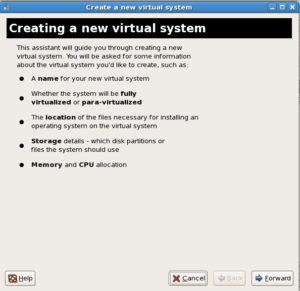


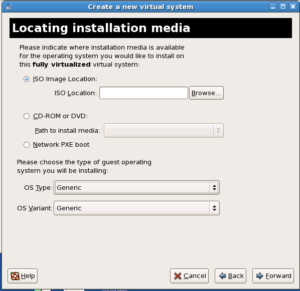

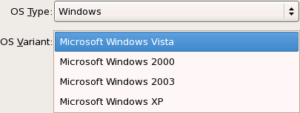





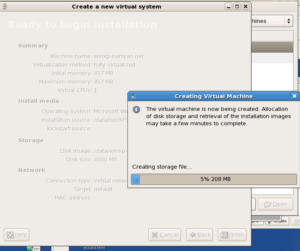
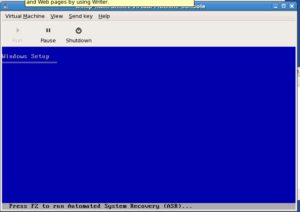


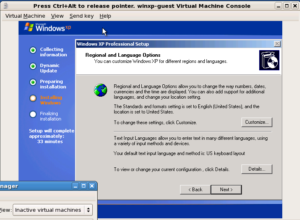
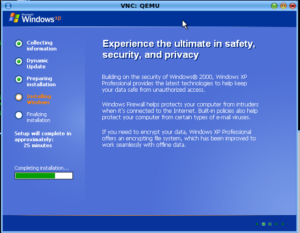



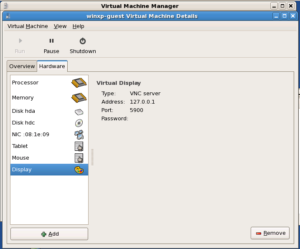


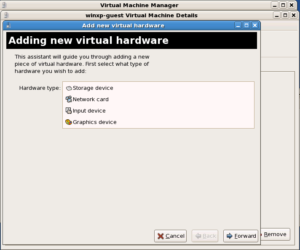
It runs perfect on my Centos 5.3! thank you.
[root@localhost ~]# yum install obexftp gnome-bluetooth
Loaded plugins: fastestmirror
Loading mirror speeds from cached hostfile
* base: http://ftp.cuhk.edu.hk
* updates: http://ftp.cuhk.edu.hk
* addons: http://ftp.cuhk.edu.hk
* extras: http://ftp.cuhk.edu.hk
Setting up Install Process
Parsing package install arguments
No package obexftp available.
Resolving Dependencies
–> Running transaction check
—> Package gnome-bluetooth.i386 0:0.7.0-10.2.el5 set to be updated
–> Processing Dependency: gnome-bluetooth-libs = 0.7.0-10.2.el5 for package: gnome-bluetooth
–> Processing Dependency: libopenobex.so.1 for package: gnome-bluetooth
–> Processing Dependency: libgnomebt.so.0 for package: gnome-bluetooth
–> Processing Dependency: libbtctl.so.2 for package: gnome-bluetooth
–> Running transaction check
—> Package openobex.i386 0:1.3-3.1 set to be updated
—> Package gnome-bluetooth-libs.i386 0:0.7.0-10.2.el5 set to be updated
—> Package libbtctl.i386 0:0.6.0-9.2.el5 set to be updated
–> Finished Dependency Resolution
Dependencies Resolved
================================================================================
Package Arch Version Repository Size
================================================================================
Installing:
gnome-bluetooth i386 0.7.0-10.2.el5 base 235 k
Installing for dependencies:
gnome-bluetooth-libs i386 0.7.0-10.2.el5 base 65 k
libbtctl i386 0.6.0-9.2.el5 base 44 k
openobex i386 1.3-3.1 base 21 k
Transaction Summary
================================================================================
Install 4 Package(s)
Update 0 Package(s)
Remove 0 Package(s)
Total download size: 365 k
Is this ok [y/N]: y
Downloading Packages:
(1/4): openobex-1.3-3.1.i386.rpm | 21 kB 00:00
(2/4): libbtctl-0.6.0-9.2.el5.i386.rpm | 44 kB 00:01
(3/4): gnome-bluetooth-libs-0.7.0-10.2.el5.i386.rpm | 65 kB 00:01
(4/4): gnome-bluetooth-0.7.0-10.2.el5.i386.rpm | 235 kB 00:02
——————————————————————————–
Total 26 kB/s | 365 kB 00:14
Running rpm_check_debug
Running Transaction Test
Finished Transaction Test
Transaction Test Succeeded
Running Transaction
Installing : openobex [1/4]
Installing : libbtctl [2/4]
Installing : gnome-bluetooth-libs [3/4]
Installing : gnome-bluetooth [4/4]
Installed: gnome-bluetooth.i386 0:0.7.0-10.2.el5
Dependency Installed: gnome-bluetooth-libs.i386 0:0.7.0-10.2.el5 libbtctl.i386 0:0.6.0-9.2.el5 openobex.i386 0:1.3-3.1
Complete!
[root@localhost ~]# sdptool browse
Inquiring …
Browsing 00:1E:37:69:33:A7 …
Browsing 00:24:7E:21:FF:BB …
Browsing 00:1E:37:6E:BE:F3 …
Service Name: Bluetooth Serial Port
Service RecHandle: 0x10000
Service Class ID List:
“Serial Port” (0x1101)
Protocol Descriptor List:
“L2CAP” (0x0100)
“RFCOMM” (0x0003)
Channel: 1
Language Base Attr List:
code_ISO639: 0x656e
encoding: 0x6a
base_offset: 0x100
Profile Descriptor List:
“Serial Port” (0x1101)
Version: 0x0100
Service Name: Network Access
Service RecHandle: 0x10001
Service Class ID List:
“PAN Group Network” (0x1117)
Protocol Descriptor List:
“L2CAP” (0x0100)
PSM: 15
“BNEP” (0x000f)
Version: 0x0100
SEQ8: 0 6 dd
Language Base Attr List:
code_ISO639: 0x656e
encoding: 0x6a
base_offset: 0x100
Profile Descriptor List:
“PAN Group Network” (0x1117)
Version: 0x0100
Service Name: Network Access
Service RecHandle: 0x10002
Service Class ID List:
“PAN User” (0x1115)
Protocol Descriptor List:
“L2CAP” (0x0100)
PSM: 15
“BNEP” (0x000f)
Version: 0x0100
SEQ8: 0 6 dd
Language Base Attr List:
code_ISO639: 0x656e
encoding: 0x6a
base_offset: 0x100
Profile Descriptor List:
“PAN User” (0x1115)
Version: 0x0100
Service Name: Dial-up Networking
Service RecHandle: 0x10003
Service Class ID List:
“Dialup Networking” (0x1103)
Protocol Descriptor List:
“L2CAP” (0x0100)
“RFCOMM” (0x0003)
Channel: 2
Language Base Attr List:
code_ISO639: 0x656e
encoding: 0x6a
base_offset: 0x100
Profile Descriptor List:
“Dialup Networking” (0x1103)
Version: 0x0100
Service Name: PIM Item Transfer
Service RecHandle: 0x10004
Service Class ID List:
“OBEX Object Push” (0x1105)
Protocol Descriptor List:
“L2CAP” (0x0100)
“RFCOMM” (0x0003)
Channel: 3
“OBEX” (0x0008)
Language Base Attr List:
code_ISO639: 0x656e
encoding: 0x6a
base_offset: 0x100
Profile Descriptor List:
“OBEX Object Push” (0x1105)
Version: 0x0100
Service Name: File Transfer
Service RecHandle: 0x10005
Service Class ID List:
“OBEX File Transfer” (0x1106)
Protocol Descriptor List:
“L2CAP” (0x0100)
“RFCOMM” (0x0003)
Channel: 4
“OBEX” (0x0008)
Language Base Attr List:
code_ISO639: 0x656e
encoding: 0x6a
base_offset: 0x100
Profile Descriptor List:
“OBEX File Transfer” (0x1106)
Version: 0x0100
Service Name: Fax
Service RecHandle: 0x10006
Service Class ID List:
“Fax” (0x1111)
Protocol Descriptor List:
“L2CAP” (0x0100)
“RFCOMM” (0x0003)
Channel: 5
Language Base Attr List:
code_ISO639: 0x656e
encoding: 0x6a
base_offset: 0x100
Profile Descriptor List:
“Fax” (0x1111)
Version: 0x0100
Service Name: PIM Synchronization
Service RecHandle: 0x10007
Service Class ID List:
“IrMC Sync” (0x1104)
Protocol Descriptor List:
“L2CAP” (0x0100)
“RFCOMM” (0x0003)
Channel: 6
“OBEX” (0x0008)
Language Base Attr List:
code_ISO639: 0x656e
encoding: 0x6a
base_offset: 0x100
Profile Descriptor List:
“IrMC Sync” (0x1104)
Version: 0x0100
Service Name: Sync Command Service
Service RecHandle: 0x10008
Service Class ID List:
“IrMC Sync Command” (0x1107)
Protocol Descriptor List:
“L2CAP” (0x0100)
“RFCOMM” (0x0003)
Channel: 6
“OBEX” (0x0008)
Language Base Attr List:
code_ISO639: 0x656e
encoding: 0x6a
base_offset: 0x100
Profile Descriptor List:
“IrMC Sync” (0x1104)
Version: 0x0100
Service Name: Headset
Service RecHandle: 0x10009
Service Class ID List:
“Headset” (0x1108)
“Generic Audio” (0x1203)
Protocol Descriptor List:
“L2CAP” (0x0100)
“RFCOMM” (0x0003)
Channel: 7
Language Base Attr List:
code_ISO639: 0x656e
encoding: 0x6a
base_offset: 0x100
Profile Descriptor List:
“Headset” (0x1108)
Version: 0x0100
Service Name: Stereo Audio
Service RecHandle: 0x1000a
Service Class ID List:
“Audio Sink” (0x110b)
Protocol Descriptor List:
“L2CAP” (0x0100)
PSM: 25
“AVDTP” (0x0019)
uint16: 0x100
Language Base Attr List:
code_ISO639: 0x656e
encoding: 0x6a
base_offset: 0x100
Profile Descriptor List:
“Advanced Audio” (0x110d)
Version: 0x0100
Service RecHandle: 0x1000b
Service Class ID List:
“AV Remote Target” (0x110c)
Protocol Descriptor List:
“L2CAP” (0x0100)
PSM: 23
“AVCTP” (0x0017)
uint16: 0x100
Profile Descriptor List:
“AV Remote” (0x110e)
Version: 0x0100
Service Name: Audio Source
Service RecHandle: 0x1000c
Service Class ID List:
“Audio Source” (0x110a)
Protocol Descriptor List:
“L2CAP” (0x0100)
PSM: 25
“AVDTP” (0x0019)
uint16: 0x100
Profile Descriptor List:
“Advanced Audio” (0x110d)
Version: 0x0100
Service Name: Bluetooth Imaging
Service RecHandle: 0x1000d
Service Class ID List:
“Imaging Responder” (0x111b)
Protocol Descriptor List:
“L2CAP” (0x0100)
“RFCOMM” (0x0003)
Channel: 8
“OBEX” (0x0008)
Language Base Attr List:
code_ISO639: 0x656e
encoding: 0x6a
base_offset: 0x100
Profile Descriptor List:
“Imaging” (0x111a)
Version: 0x0100
Service Name: Audio Gateway
Service RecHandle: 0x1000e
Service Class ID List:
“Headset Audio Gateway” (0x1112)
“Generic Audio” (0x1203)
Protocol Descriptor List:
“L2CAP” (0x0100)
“RFCOMM” (0x0003)
Channel: 9
Profile Descriptor List:
“Headset” (0x1108)
Version: 0x0100
Service Name: Audio Gateway
Service RecHandle: 0x1000f
Service Class ID List:
“Handfree Audio Gateway” (0x111f)
“Generic Audio” (0x1203)
Protocol Descriptor List:
“L2CAP” (0x0100)
“RFCOMM” (0x0003)
Channel: 10
Profile Descriptor List:
“Handsfree” (0x111e)
Version: 0x0101
Browsing 00:21:86:C2:4B:5A …
Failed to connect to SDP server on 00:1E:37:69:1F:51: Host is down
Browsing 00:24:7E:98:97:23 …
********************QUESTION*********************
why it shows that no package obexftp available
and after that what is that hanphone…????
can u post it with few more screenshot of commands also…so that its get easyyyyyyyy
waitingggggggggggggggggg….
thanxxxxxxxxxxxxxxxxxxxxxxxxxxxxxxx
You might need to add rpmforge repo as per this link..
http://dag.wieers.com/rpm/FAQ.php#B2
obexfs command not found…
how to resolve???
yum installation not workingggggggg
what to doooooooo???
Well.
I install with succes all in centos 5.4 the latest version with latest update and when i type obex:// in my computer address :
Nautilus cannot disply “obex:///”
Please select another viewer and try again.
???